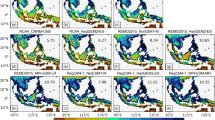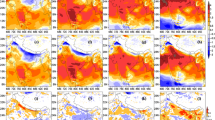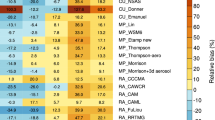Abstract
A hybrid seasonal forecasting approach was generated by the National Centers for Environmental Prediction operational Climate Forecast System (CFS) and its nesting Climate extension of Weather Research and Forecasting (CWRF) model to improve forecasting skill over the United States. Skills for the three summers of 2011–2013 were evaluated regarding location, timing, magnitude, and frequency. Higher spatial pattern correlation coefficients showed that the hybrid approach substantially improved summer mean precipitation and 2-m temperature geographical distributions compared with the results of the CFS and CWRF models. The area mean temporal correlation coefficients demonstrated that the hybrid approach also consistently improved the timing prediction skills for both variables. In general, the smaller root mean square errors indicated that the hybrid approach reduced the magnitude of the biases for both precipitation and temperature. The greatest improvements were achieved when the individual models had similar skills. The comparison with a North American multi-model ensemble further proved the feasibility of improving real-time seasonal forecast skill by using the hybrid approach, especially for heavy rain forecasting. Based on the complementary advantages of CFS the global model and CWRF the nesting regional model, the hybrid approach showed a substantial enhancement over CFS real-time forecasts during the summer. Future works are needed for further improving the quality of the hybrid approach through CWRF’s optimized physics ensemble, which has been proven to be feasible and reliable.









Similar content being viewed by others
References
Candille G (2009) The multiensemble approach: the NAEFS example. Mon Weather Rev 137:1655–1665
Chen M, Shi W, Xie P, Silva VBS, Kousky VE, Higgins RW, Janowiak JE (2008) Assessing objective techniques for gauge-based analyses of global daily precipitation. J Geophys Res 113:D04110. doi:10.1029/2007JD009132
Delworth TL et al (2006) GFDL’s CM2 global coupled climate models. Part I: formulation and simulation characteristics. J Clim 19:643–674. doi:10.1175/JCLI3629.1
Feser F, von Storch H, Rockel B, Winterfeldt J, Zahn M (2011) Regional climate models add value to global model data: a review and selected examples. Bull Am Meteorol Soc 92:1181–1192. doi:10.1175/2011BAMS3061.1
Hagedorn R, Doblas-Reyes FJ, Palmer TN (2005) The rationale behind the success of multi-model ensemble in seasonal forecasting—I. Basic concept. Tellus Ser A 57:219–233. doi:10.1111/j.1600-0870.2005.00103.x
Hewitt CD (2004) Ensembles-based predictions of climate changes and their impacts. EOS Trans AGU 85:566–567
Hong S-Y, Kanamitsu M (2014) Dynamical downscaling: fundamental issues from an NWP point of view and reccomendations. Asia Pac J Atmos Sci 50(1):83–104. doi:10.1007/s13143-014-0029-2
Kanamitsu M, Dehaan L (2011) The Added Value Index: a new metric to quantify the added value of regional models. J Geophys Res. doi:10.1029/2011JD015597
Kimoto M, Yasutomi N, Yokoyama C, Emori S (2005) Projected changes in precipitation characteristics around Japan under the global warming. SOLA 1:85–88
Kirtman BP, Min D (2009) Multimodel ensemble ENSO prediction with CCSM and CFS. Mon Weather Rev 137:2908–2930
Kirtman BP et al (2014) The North American Multimodel Ensemble: phase-1 seasonal-to-interannual prediction; phase-2 toward developing intraseasonal prediction. Bull Amer Meteor Soc 95:585–601
Leung LR, Mearns LO, Giorgi F, Wilby RL (2003) Regional climate research. Bull Am Meteorol Soc 84:89–95. doi:10.1175/BAMS-84-1-89
Liang X-Z, Xu M, Kunkel KE, Grell GA, Kain J (2007) Regional climate model simulation of US-Mexico summer precipitation using the optimal ensemble of two cumulus parameterizations. J Clim 20:5201–5207
Liang X-Z et al (2012) Regional climate-weather research and forecasting model. Bull Amer Meteor Soc 93:1363–1387
Liu S, Gao W, Xu M, Wang X, Liang X-Z (2009) China summer precipitation simulations using an optimal ensemble of two cumulus schemes. Front Earth Sci China 3:248–257
Liu S, Liang X-Z, Gao W, Stohlgren TJ (2014) Regional climate model downscaling may improve the prediction of alien plant species distributions. Front Earth Sci China 8:457–471
Mason IB (2003) Binary events. In: Jolliffe IY, Stephenson DB (eds) Forecast verification—a practitioner’s guide in atmospheric science. Wiley, New York, pp 37–76
Maurer EP, Hidalgo HG (2008) Utility of daily vs. monthly large-scale climate data: an intercomparison of two statistical downscaling methods. Hydrol Earth Syst Sci 12:551–563
Molod A, Takacs L, Suarez M, Bacmeister J, Song I-S, Eichmann A (2012) The GEOS-5 atmospheric general circulation model: mean climate and development from MERRA to Fortuna. Technical Report Series on Global Model Data Assimilation, vol 28. NASA Goddard Space Flight Cent., Greenbelt, p 175
Palmer TN et al (2004) Development of a European multimodel ensemble system for seasonal-to-interannual prediction. Bull Am Meteorol Soc 85:853–872
Saha S et al (2010) The NCEP climate forecast system reanalysis. Bull Am Meteorol Soc 91:1015–1057. doi:10.1175/2010BAMS3001.1
Saha S et al (2014) The NCEP climate forecast system version 2. J Clim 27:2185–2208
Sasaki H, Murata A, Hanafusa M, Ohizumi M, Kurihara K (2011) Reproducibility of present climate in a non-hydrostatic regional climate model nested within an atmosphere general circulation model. SOLA 7:173–176. doi:10.2151/sola.2011-044
Shukla S, Lettenmaier DP (2013) Multi-RCM ensemble downscaling of NCEP CFS winter season forecasts: Implications for seasonal hydrologic forecast skill. J Geophys Res Atmos 118:10,770–10,790. doi:10.1002/jgrd.50628
Wood AW, Maurer EP, Kumar A, Lettenmaier DP (2002) Long-range experimental hydrologic forecasting for the eastern United States. J Geophys Res 107:D204429. doi:10.1029/2001JD000659
Yoon D-H, Leung LR, Correia J Jr (2012) Comparison of dynamically and statistically downscaled seasonal climate forecasts for the cold season over the United States. J Geophys Res 117:D21109. doi:10.1029/2012JD017650
Yuan X, Liang X-Z (2011) Improving cold season precipitation prediction by the nested CWRF-CFS system. Geophys Res Lett 38:L02706. doi:10.1029/2010GL046104
Acknowledgments
This research was supported by NOAA’s Education Partnership Program COM Howard 0007342100004640603 and the NOAA’s Cooperative Institute for Climate & Satellite 5276410. The views expressed are those of the authors and do not necessarily reflect those of the sponsoring agencies and the Earth System Science Interdisciplinary Center, University of Maryland. Any use of trade, product, or firm names is for descriptive purposes only and does not imply endorsement by the US Government.
Author information
Authors and Affiliations
Corresponding author
Rights and permissions
About this article
Cite this article
Liu, S., Wang, J.X.L., Liang, XZ. et al. A hybrid approach to improving the skills of seasonal climate outlook at the regional scale. Clim Dyn 46, 483–494 (2016). https://doi.org/10.1007/s00382-015-2594-1
Received:
Accepted:
Published:
Issue Date:
DOI: https://doi.org/10.1007/s00382-015-2594-1




